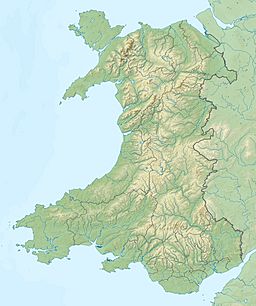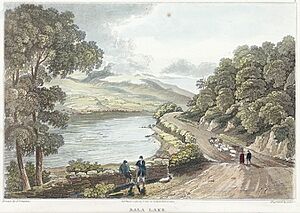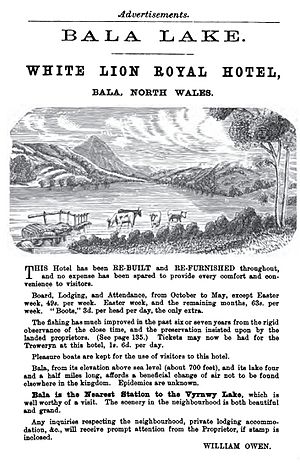Bala Lake facts for kids
Quick facts for kids Bala Lake |
|
|---|---|
| Welsh: Llyn Tegid | |

View from Bala
|
|
| Location | Wales |
| Coordinates | 52°53′N 3°38′W / 52.883°N 3.633°W |
| Type | natural |
| Primary inflows | River Dee |
| Primary outflows | River Dee |
| Basin countries | United Kingdom |
| Max. length | 3.7 mi (6.0 km) |
| Max. width | 0.5 mi (0.8 km) |
| Surface area | 1.87 sq mi (4.8 km2) |
| Max. depth | 138 ft (42 m) |
| Settlements | Bala |
| Official name: Llyn Tegid | |
| Designated: | 7 November 1991 |
| Reference #: | 535 |
Bala Lake, also known as Llyn Tegid in Welsh, is a beautiful lake in Gwynedd, Wales. The name Tegid might come from the Welsh word teg, which means "fair" or "beautiful".
This lake was the largest natural body of water in Wales. Its water level was later raised by a famous engineer named Thomas Telford. This was done to help provide water for the Ellesmere Canal. Bala Lake is about 3.7 miles (6.0 km) long and 0.5 miles (0.8 km) wide. The River Dee flows through the lake, and its waters are known for being deep and clear.
The town of Bala is located at the north-eastern end of the lake. A fun narrow gauge train, the Bala Lake Railway, runs for 3 miles (4.8 km) along the south-eastern shore. It continues to the village of Llanuwchllyn, whose name means "church above the lake".
Contents
How Bala Lake Was Formed
The lake sits in a valley that was carved out by a glacier long ago. This valley follows a natural crack in the Earth called the Bala to Tal-y-Llyn fault line. As the glacier moved, it left behind a pile of rocks and dirt called a terminal moraine near the village of Bala. This moraine blocked the valley, creating the lake. That's why the lake has fairly straight and parallel sides.
What's in a Name?
The lake is often called Bala Lake because it's near the town of Bala. In Welsh, the name Bala means "outlet of a lake".
A writer named George Borrow visited the lake in 1856. He wrote that the lake's Welsh name, Llyn Tegid, means "Lake of Beauty". He felt the name was perfect for such a lovely place.
Amazing Wildlife
Llyn Tegid is home to many different fish, including pike, perch, brown trout, roach, and eel.
It also has a very special fish called the gwyniad. This fish is found only in Bala Lake! Sadly, it's listed as critically endangered by the IUCN. This is mainly because another fish, the ruffe, was introduced to the lake and competes with the gwyniad.
You can also find a very rare snail here called the Myxas glutinosa, also known as the glutinous snail.
For a while in the 1990s, the lake had problems with "blue-green algae" blooms. This meant there was too much pollution, which made the lake unhealthy. But experts worked together to reduce pollution, and the lake is now much cleaner.
How the Lake Helps with Water Supply
Bala Lake is an important part of the River Dee regulation system. This means its water level is carefully controlled. Depending on how much water is flowing and the level of water in Llyn Celyn, water can flow into or out of Bala Lake.
Engineers like Thomas Telford first built controls for the lake's water level around 1840. These controls helped make sure the Ellesmere Canal had enough water. Today, new controls help prevent flooding and ensure that towns like Wirral in England get fresh water from the River Dee.
A Lake of Legends
There's a cool legend about Bala Lake! It's part of the story of Taliesin, a famous Welsh poet. The legend says that a character named Tegid Foel (which means "Bald Tegid") lived in a court that is now under the lake's waters.
According to folk tales, his court was flooded one night. People say that on a clear, moonlit night, you can sometimes see the lights of the old court and the small town around it beneath the water.
Fun Things to Do
Bala Lake is a great place for outdoor activities! There are two sailing clubs where you can learn to sail. Many companies also rent out kayaks, yachts, and other types of boats. It's a perfect spot for water sports and enjoying nature.
Images for kids
-
The gwyniad, a fish found only in this lake.
See also
 In Spanish: Lago Bala para niños
In Spanish: Lago Bala para niños






